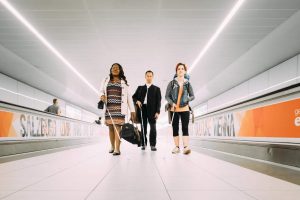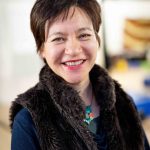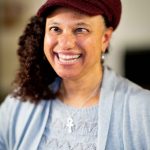Artistic Directors Kumiko Mendl & Maria Oshodi discuss their co-production of Flight Paths

Inspired by the Japanese Goze; female musicians who would travel around medieval Japan to tell their stories to make a living, both Yellow Earth and Extant Theatre have teamed up to create a multi-disciplinary piece exploring what it means to navigate a world being a visually impaired performer. Flight Paths will witness two female performers take centre-stage as they perform a mixture of verbatim interviews and aerial sequences choreographed by Upswing’s Vicki Amedume. Ahead of their first few shows at the Harlow Playhouse Theatre and Stratford Circus, both Artistic Directors Kumiko Mendl and Maria Oshodi spoke to us about the creation of the show.
Extant Theatre, in collaboration with Yellow Earth will debut Flight Paths at the Harlow Playhouse Theatre on 5thFebruary before moving onto Stratford Circus on the 8th & 9th February before going on tour. How are you feeling ahead of the show?
 K:I’m very excited! It has many elements to it and it’s the first time I’ve worked with Maria, who’s the Artistic director of Extant so that’s been new for us. Discovering how we work together in the room and with the artists, that’s been really interesting and fascinating. Working with someone who also is a blind director and myself sighted, [it’s] finding what the aesthetic is and how we navigate together. I’m really excited to see how an audience receives this as blind and non-blind audiences, that’s going to be very interesting, I’m looking forward to that.
K:I’m very excited! It has many elements to it and it’s the first time I’ve worked with Maria, who’s the Artistic director of Extant so that’s been new for us. Discovering how we work together in the room and with the artists, that’s been really interesting and fascinating. Working with someone who also is a blind director and myself sighted, [it’s] finding what the aesthetic is and how we navigate together. I’m really excited to see how an audience receives this as blind and non-blind audiences, that’s going to be very interesting, I’m looking forward to that.
 M:I’m feeling buried. Buried in the whole array of things that need to be knitted together. We are doing every minute of rehearsal time on every level which is the complex aerial work, how we integrate the audio description in that, how we make that accessible for a blind person in the room, how the aerialists are doing circus that is then authentic and good and also in sync, and when there are two blind performers who don’t have any visual cues, that’s something that we need to all agree on in terms of accepting the whole arc of the piece, how music fits with that, how we then have their voices projecting over music, which is a very difficult thing to do when you’re in the middle of physical movement and having to record that and having all of these technologies project onto them, their own voices, so that we have amplified voices that are in the very positions and states that their bodies are in, [it’s] a mastery of the space. Alongside that, there’s all the usual stuff that goes round to opening a show – it’s like creating a theatre piece twice.
M:I’m feeling buried. Buried in the whole array of things that need to be knitted together. We are doing every minute of rehearsal time on every level which is the complex aerial work, how we integrate the audio description in that, how we make that accessible for a blind person in the room, how the aerialists are doing circus that is then authentic and good and also in sync, and when there are two blind performers who don’t have any visual cues, that’s something that we need to all agree on in terms of accepting the whole arc of the piece, how music fits with that, how we then have their voices projecting over music, which is a very difficult thing to do when you’re in the middle of physical movement and having to record that and having all of these technologies project onto them, their own voices, so that we have amplified voices that are in the very positions and states that their bodies are in, [it’s] a mastery of the space. Alongside that, there’s all the usual stuff that goes round to opening a show – it’s like creating a theatre piece twice.
Flight Paths is inspired by the tradition of the Japanese Goze – a tradition whereby blind female performers travelled around medieval Japan making a living from telling epic tales. How has this concept been adapted for a modern day audience?
K: Initially we didn’t know anything about the Goze, which is typical because it’s women’s history. We knew about the Biwa Hoshi which was the tradition of male blind artists who would make their living by singing and telling their stories and moving around the country, then subsequently found out about the Goze. That felt much closer to us as women directors and as female performers and also the fact that that’s how they survived. As artists, they made their living through their music and this very much pertains to all the artists we were working with on this project. They’ve all come to this country, they’ve come from four corners of the globe to come here, to make a living as artists, to find their independence and freedom as it were. It underpins the piece.
M: It’s telling contemporary stories of these real life people and how they travelled here to live in the UK.
The show weaves together the personal lives of four performers – Amelia Cavallo and Sarah Houbolt with Takashi Kikuchi and Victoria Oruwari, their stories spanning Japan, Nigeria, USA and Australia. What was the process in terms of devising the show with the performers?
K: It’s a project that has been on going for nearly 5 years now. When we first started out, we had a group of four artists and of course over the years, when we come back to meet together not everyone is available, so it’s slightly shifted over time. One of the main things is that we wanted to capture their stories, their own personal stories of coming here as artists of colour and blind artists, so we conducted interviews. It’s mainly verbatim and there’s interviewing sections. There’s also live performance on stage, then we also interweave that with the aerial, which brings together the themes through the physicality and in terms of their endeavour and what it takes to make that journey.
M: Long and hard. We worked with Amelia, Takashi and Victoria initially, then we lost Takashi and Victoria due to other work commitments so we brought them into the show in an interesting and original way that has enhanced the show I think, giving it its signature.
Flight Paths is a collaboration between Yellow Earth and Extant Company, how have you both worked together to create the show?
K: Once a year we’d meet, we managed to bring together the artists and ourselves and we’d explore different aspects of the play, whether that be integrated audio description, the sound design, the stories, the artists, the aerial, so it’s been layered, there’s many layers to it. Through that process, I got to know Maria well and we had a good relationship working together and could see that this will be really exciting. It’s been an exciting process from start to finish, it’s a discovery all along the way, and as a theatre practitioner and director who, one takes one’s sight for granted, it’s never occurred to me making theatre for someone who doesn’t see, but that’s been really important and that’s impacted on our work to make sure that the work Yellow Earth does is accessible to everybody. Also, there’s a strong emphasis on the sound/aural and that’s been really good as well for my own practise.
M:Kumiko and I have worked very closely with Vicki Amedume who’s movement director of The Sustain Theatre London Hub that were an organisation led by people of colour and we had something very interesting to explore together so we started the journey from there. I brought Amelia, Takashi and Victoria together because I knew them and thought let’s see what we can do. We started in 2013 and continuing more or less every year, R&D, picking up from where we left off, we’ve got to this point where we’re ready to go now!
The show will also include aerial silk work choreographed by Upswing Artistic Director Vicki Amedume. How have you worked together to create the show?
M: Glen [Neath] has written a piece from verbatim interviews, then there’s been a lot more script development that has happened in and around that with the introduction of Sarah and her story. Then also bringing in the whole Goze and Biwa Hoshi theme and [we] did some inventing around that. Vicki has wanted to know what this journey is, so she could create the aerial language to fit the piece, she’s very clear on that and now she’s come back with a really lovely and intelligent sequence of episode and a final routine that are embedded in the piece.
Is there anything that you’ve learned from creating the show, whether that be from the sound/aural aspect, or anything else in particular?
K: Paying attention. Our contemporary world is very visually led; visuals are very dominant. To just step back, to take the aural aspect in is as important as the visual, one does that in a show but to really think more deeply about that. To think about access, that’s really important, so that everybody can get an experience of the play in a full and richer way as possible.
Another crucial aspect of the show will be the audio descriptive and sound design element in which you’ve teamed up with surround-sound technologist Tarim. What was the process in terms of experimentation with sound design?
M: That was something that I was keen on from the start; whenever I’ve been to performances where there’s movement and they’re in large spaces, and shows either indoors or outdoors, if there’s been anything that’s around music, text or description which is actually quite rare to get, it’s come out of a speaker that’s a distance away from where the performers are performing so as a visually impaired person I’d look to a sound source and not be anyway engaged with where the performers were in the space. My question was, ‘Can we find a way to project the sound source onto where exactly the performer’s bodies are in the space?’, and that’s what we’ve managed to achieve.
What can audiences expect from Flight Paths?
K: It’s going to be funny, it’s going to be moving, it’s going to be awe-inspiring. There’s something about watching aerial, which is magnetic. We’re also deconstructing it in a way so that’s really exciting, it’s not just going to be a circus show, like Cirque du Soleil, that’s going to be very impressive!
M: To be enthralled, to be moved, to be entertained, to learn something interesting about history and other cultures.
What would you like for audiences to take away from the show?
K: I want them to think about what people have to go through, for people who are visually impaired, what barriers they are up against and how inaccessible the contemporary world actually is to an extent. It is hard, they have to work twice as hard and I think that’s very much the same for minorities, communities, artists as well. They’re going to discover something about the Goze, the Biwa Hoshi, they’re going to enjoy the aural and audio description, they’re going to feel uplifted and they’ve learned something which is great.
Interview by Lucy Basaba.
Flight Paths will show on Tuesday 5th February at Harlow Playhouse Theatre, and then will move onto Stratford Circus on Friday 8th and Saturday 9th February 2019 before going on tour. For more information on the production, visit here…
Harlow Playhouse Theatre – Tues 5th February 2019
Stratford Circus – Friday 8th & Saturday 9th February 2019
To listen to the Flight Paths preview podcast, visit here…


Leave a Comment